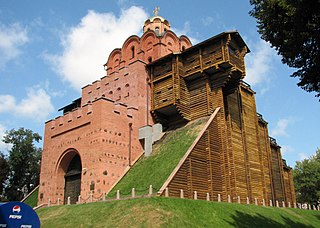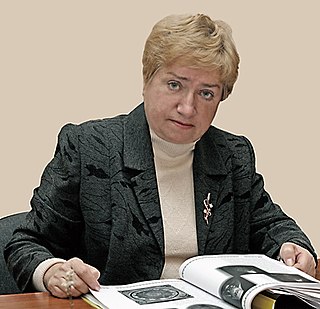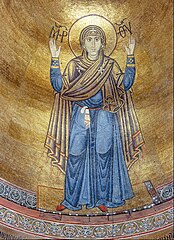
Kaniv is a city in Cherkasy Raion, Cherkasy Oblast, central Ukraine. The city rests on the Dnieper River, and is one of the main inland river ports on the Dnieper. It is an urban hromada of Ukraine. Population: 23,172.

Kyiv-Pechersk Lavra or Kyievo-Pecherska Lavra, also known as the Kyiv Monastery of the Caves, is a historic Eastern Orthodox Christian monastery which gave its name to one of the city districts where it is located in Kyiv.

The Ukrainian Orthodox Church – Kyiv Patriarchate is an Orthodox church in Ukraine, and self-identifies as the successor to the original Kyivan Ruthenian Patriarchate. It came into existence in 1992, and had the largest number of Orthodox Christian followers in all of Ukraine for most of its primary existence.

St Volodymyr's Cathedral is a cathedral in the centre of Kyiv. It is one of the city's major landmarks and was the mother cathedral of the Ukrainian Orthodox Church – Kyiv Patriarchate before the Unification council of the Eastern Orthodox churches of Ukraine.

Anthony of Kiev, also called Anthony of the Caves, was a monk and the founder of the monastic tradition in Kievan Rus'. Together with Theodosius of Kiev, he co-founded the Kiev Pechersk Lavra.

Ukrainian Baroque, also known as Cossack Baroque or Mazepa Baroque, is an architectural style that was widespread in the Ukrainian lands in the 17th and 18th centuries. It was the result of a combination of local architectural traditions and European Baroque.

Alphabetical list of Eastern Christianity-related articles on English Wikipedia

St. Michael's Golden-Domed Monastery is a monastery in Kyiv, the capital of Ukraine, dedicated to Saint Michael the Archangel. It is located on the edge of the bank of the Dnipro river, to the northeast of the St Sophia Cathedral. The site is located in the historical administrative neighbourhood of Uppertown and overlooks Podil, the city's historical commercial and merchant quarter. The monastery has been the headquarters of the Orthodox Church of Ukraine since December 2018.

Volodymyr was a Ukrainian Eastern Orthodox priest and human rights activist who was Patriarch of the Ukrainian Orthodox Church – Kyiv Patriarchate from its founding until his death. Prior to becoming patriarch, he had been a prisoner of conscience and one of the leaders of the Ukrainian Helsinki Group.

The Gate Church of the Trinity is a historic church of the cave monastery of the Kyiv Pechersk Lavra in Kyiv, the capital of Ukraine. Originally being built as in the church style of Kievan Rus', the Gate Church of the Trinity is now decorated in the Ukrainian Baroque style, having been reconstructed many times through its history.

The Seven Wonders of Ukraine are seven historical and cultural monuments of Ukraine, which were chosen in the Seven Wonders of Ukraine contest held in July, 2007. This was the first public contest of that kind which was followed by the Seven Natural Wonders of Ukraine, the Seven Wonderful Routes of Ukraine, and the Seven Wonderful Castles of Ukraine. All nominated sites are publicly owned protected areas of at least regional level, available for tourism.

Ukrainian architecture has initial roots in the Eastern Slavic state of Kievan Rus'. After the Mongol invasion of Kievan Rus', the distinct architectural history continued in the principalities of Galicia-Volhynia and later in the Grand Duchy of Lithuania. During the epoch of the Zaporozhian Cossacks, a style unique to Ukraine developed under the influences of the Polish–Lithuanian Commonwealth.

Ancient Chernihiv is the National Architecture-Historical Reserve located in the north-eastern Ukrainian city of Chernihiv. It was created at first as an affiliate of the National Sanctuary "Sophia of Kyiv". Since August 1, 1967, the site is a separate entity consisting of 34 monuments of architecture.

Eparchy of Kyiv is the central eparchy (diocese) and metropolis of the Orthodox Church of Ukraine. The eparchy covers the territory of Kyiv Oblast and most of the city of Kyiv.

Latin Church in Ukraine (LCiU), also officially Roman Catholic Church in Ukraine (RCCiU) is the Latin Church of the Catholic Church in Ukraine. The Latin Church is one of four sui iuris Catholic churches in Ukraine, the others being the Ukrainian Greek Catholic Church, the Ruthenian Greek Catholic Church, and the Armenian Catholic Church, all in full communion with each other and the Pope. The Latin Church presence performs its liturgies according to the Latin liturgical rites.

The Metropolis of Kyiv was an autonomous metropolis of the Ecumenical Patriarchate of Constantinople with center in Kyiv after its formation in 988 as a result of the Christianization of Rus by Volodymyr the Great until January 6, 2019, when it received the Tomos on Autocephaly.

The Bell Tower of Saint Sophia Cathedral in Kyiv is a monument of Ukrainian architecture in the style of Ukrainian (Cossack) Baroque. It is one of the Ukrainian national symbols and symbols of the city of Kyiv.

Nadiia Mykolaiivna Nikitenko is a Ukrainian historian, culturalist, museologist, doctor of historical sciences (2003), researcher of Saint Sophia Cathedral, professor (2005), and Merited Culture Worker of Ukraine (2009).
Icon-painting School of the Kyiv Pechersk Lavra has long been the center of Kievan Rus and Ukrainian painting. It was founded by Alipy Pechersky at the beginning of the 12th century.

































